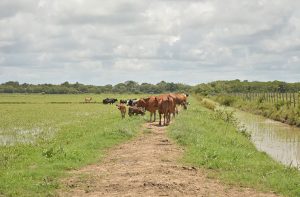LONG before the downturn in the rice industry, the Sankar family, who were at one time the largest rice producers on the Essequibo Coast, made a decision to diversify into other areas of agriculture.Today, they no longer are into rice cultivation, but still operate their rice mill and are into coconut oil production, goat-rearing and aquaculture and cattle-rearing, as well as poultry on a smaller scale.
These are done mainly on lands once used for rice cultivation on their sprawling, beautiful estate outfitted with an airstrip at Hampton Court.
Rajesh Ramnauth, the nephew of industry captain Kayman Sankar, said the Sankar family moved away from rice due to shifting dynamics in the rice industry among “other” factors, and have not regretted the move to diversify.

Driven by an entrepreneurial spirit, perhaps inherited from his famous uncle, Ramnauth, 40, a decade ago diverted his energy towards livestock and aquaculture.
Starting with 50 goats, today he has a herd of 50 of mixed Boer stock, as well as some 25 acres of tambaqui and tilapia, all of which he manages with the help of a farmhand.
Some of the fish are reared in rows of artificial aquaculture ponds.
Originally, he began with sheep, but gradually phased out to goats, since the latter litter every six months as opposed to the former, which lamb once every year.
On Ramnauth’s farm, all the animals are tagged and breeders, recently mothers and lambs and goats that have reached the age of maturity, are separated and duly cared for.
Since they are not pure bred, their growth rate and weight are below that of the original Boers, but Ramnauth has been making efforts to improve the genetics of his stock.
He told the Guyana Chronicle that he has applied to the Guyana Livestock Development Authority to artificially inseminate his stock to improve their genetic quality, but is yet to receive a response, even though the authority has been given several reminders.
NOT ADEQUATE
With a stock of 250, the young businessman said he does not have an adequate number to “hold down” a market and would usually sell to supermarkets, shops and restaurants when stocks are available.
“I also supply households and wedding houses and look forward to expanding, but important in all of this is improving the quality of breed of my animals in terms of weight and size,” he said, as he glanced over to his livestock from his verandah.
The largest goat herder on the Essequibo Coast, Ramnauth said the industry has great potential but needs attention from Government in terms of veterinary services and expert advice, to move forward.
Since the industry is small, he said it is important that farmers form themselves into cluster groups, as this will help them to maintain markets secured, pointing out that they will not be able to do so individually.
The shift from rice to goat-rearing after all might not be a bad move. On average, a rice farmer earns about $80,000 per acre after much work, but with goat meat at $600 per pond wholesale, a herder makes that money from the sale of three 40-pound plus animals.
And while the prices for tilapias and tambaqui have been fluctuating, there is a demand from residents, restaurants and dealers in the fish business.
Unlike tilapias, tambaqui, a Brazilian fish, is not popular with Essequibo Coast residents, but is a delicacy among Brazilian miners in the interior regions of Guyana.
According to Ramnauth, the fish is not a popular dish among Essequibians because of how it is prepared.
NOT FOR CURRY
“People on the Essequibo Coast and other parts of Guyana are accustomed to curry fish, but is not a fish that will stand out in a fish curry, but will be quite different if it is grilled and that is how it should be prepared,” he said.

At $400 on a flat day, and $800 on a good day for a pound of tilapia and tambaqui, and with 25 acres of ponds under cultivation with an average of 2000 fish per pond, Ramnauth, though an ambitious businessman, looks a man at ease.
Beni Sankar of the Sankar family is also now into the coconut industry and is a well-known producer of Virgin Coconut Oil on the Essequibo Coast.
The coconut industry also has great potential.
One acre of coconut produces around 7000 nuts per annum, and at $50 per nut, a coconut farmer easily earns $350,000 a year, more than double the amount of money a rice farmer earns annually per acre of rice.
Some of the best coconuts are found in the Pomeroon and there alone, there are about some 20,000 acres of land that can be cultivated.
If placed under cultivation, it will produce an estimated yield of 140 million nuts per year, and at $50 per nut, it is a $7B enterprise waiting to be tapped.

The value-added products of coconut, which includes coconut oil, craft, and coconut water, is also worth about $7B, President of the Essequibo Chambers of Commerce and seasoned businessman Dileep Singh told the Guyana Chronicle.
Low prices, lack of markets and unfavourable weather also have pushed another prominent Essequibo Coast businessman and rice farmer Roopan Ramotar into diversification.
He is still into rice cultivation, but is now giving much of his attention to coconut cultivation and is the producer of the popular Rooster brand of coconut water, some of which are exported to Trinidad and Tobago.
Aside from coconut, Ramotar is also into banana and plantain cultivation, cattle- rearing and aquaculture.
A farmer for more than 20 years, he related that soon after the low price for rice began to bite, he changed course and adopted a new approach to rice-farming.
Ramotar no longer cultivates 500 acres of rice twice per year as he used to; instead, he now divides his rice land between cattle-rearing and rice cultivation.
ROTATION
Some 250 acres are devoted to rice one crop and the remaining acres are for cattle. These areas are switched around the next crop.

“In this way, I have been able to cut back on the money I spent on fertiliser, because the cows grazing on the land have contributed significantly in keeping the land fertile. This also, in turn, has resulted in a higher quality and yield of paddy. This is how I managed to be still producing rice. With farmers getting low prices for their paddy, it cannot be business as usual. Farmers will have to think outside the box if they want to stay in business, and it is very important that they embrace diversification,” Ramotar, who is also a contractor and miller, said.
According to him, Guyana, in recent years, has been overproducing rice and this needs to stop, and more emphasis placed on controlled production, to avoid stockpiling and minimise farmers’ suffering from losses.
“Planting less and producing high-quality paddy will improve demand; and with this happening, the price for rice will go up and farmers will get more money. And this will be supplemented by the incomes they earn from their cattle, sheep, or fish farms,” he contended.
Samad Baksh, 63, who is also a well-known businessman on the Essequibo Coast, has been calling on rice farmers to diversify and to give attention to the dairy industry.
According to him, on the Essequibo Coast alone, there is an industry worth $18B annually that is untapped.

“The consumption of local milk is very small. On the Essequibo Coast, it is probably less than five per cent. There are about 50,000 people on the Essequibo Coast, and let us say on average they would need at least a pint of milk per day, which can be sold at $100 per pint, that’s $18B a year. At present, the Essequibo Coast does not have the capacity to serve that volume of milk, but it has land and the ability to develop capacity,” said Baksh, who operates a supermarket, a rice mill, a poultry farm, and a chowmein factory.
With a staff of 250, he is among the largest employers on the Essequibo Coast.
Like these established businessmen, the Sankar family has embraced diversification, and was the first to do so, as they say it as a necessary step to stay in business and keep afloat.




.jpg)










